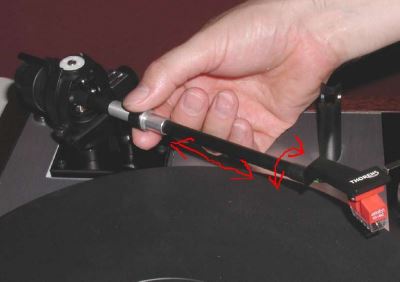The Thorens tonearm is suspended by gimbal-pivot bearings. With the tonearm out of its locks, holding the armtube between two fingers, we shouldn’t feel any “play” at the tonearm’s pivot, where the bearings allow for vertical and horizontal motion (picture below, from rudi-zampa.at). If there is no play it may also mean the bearings are too tight: when the stylus is dragged by the groove towards the record’s center, it is mandatory that the bearings won’t offer any resistance at all to this movement.
In order to verify that the tonearm be free of moving on the horizontal and vertical planes, we should do the following: remove the tonearm from the tonearm lock keeping the needle out of the platter; set antiskating to zero; balance the tonearm by means of its counterweight so it is suspended in midair, not touching the cueing bar (the headshell well above the pivot’s height); when gently blowing on the cartridge both on the side and from above, the tonearm should be free of moving. If it does not happen we have to adjust the bearings. If we feel tonearm play, we have to adjust the bearings, too.
 Above the pivot there is a small plastic cap covering the bearing adjustment screw for the horizontal movement (picture above). If there is play you should tighten the screw; if the tonearm does not move by blowing horizontally it must be released until the tonearm can move without play. Bearings are very delicate, you should pay great attention making small adjustments, using absolutely no strength in tightening the screw! The adjustment of the vertical movement is carried out by a pair of screws on the sides of the tonearm pivot (picture below). It works the same: gently tighten or loosen until the correct degree of freedom is achieved (no play and free motion when gently blowing above the headshell).
Above the pivot there is a small plastic cap covering the bearing adjustment screw for the horizontal movement (picture above). If there is play you should tighten the screw; if the tonearm does not move by blowing horizontally it must be released until the tonearm can move without play. Bearings are very delicate, you should pay great attention making small adjustments, using absolutely no strength in tightening the screw! The adjustment of the vertical movement is carried out by a pair of screws on the sides of the tonearm pivot (picture below). It works the same: gently tighten or loosen until the correct degree of freedom is achieved (no play and free motion when gently blowing above the headshell).
After these adjustments we need to restore both antiskating and vertical tracking force as in the relevant pages.

